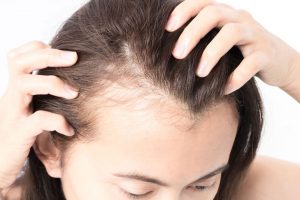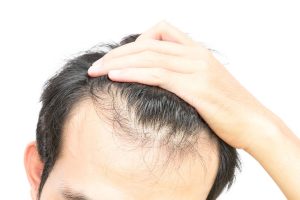 Elizabeth Miller, ND
Elizabeth Miller, ND
Naturopathic Physician
Read Biography Schedule an Appointment
While hair thinning is ubiquitous with aging, for many women an acceleration of hair loss may be experienced during menopause. In one study, it was reported that over fifty percent of the 178 postmenopausal women in the study experienced female pattern hair loss of varying severity 1.
Testosterone and DHT are two main drivers of female pattern hair loss. During menopause, there is an abrupt drop of estrogen and progesterone levels, while testosterone remains on a slow decline. This now looks like an imbalance of testosterone, in comparison to estrogen and progesterone levels. Additionally when estrogen drops, so does Sex Hormone Binding Globulin (SHBG). SHBG binds testosterone, lowering testosterone’s ability to have an effect on tissues. This is why during menopause we also see a rise in free testosterone 2. This imbalance of hormones plus rise in free testosterone may increase or initiate female pattern hair loss (2).
Estrogen has a positive effect on the hair growth cycle, follicle and scalp health, and as we know it declines rapidly during menopause. Hormone replacement therapy may support hair, however this is not seen in all women. When considering initiating hormone replacement therapy it is important to consider all symptoms of menopause being experienced such as hot flashes as it is not recommended solely for hair loss.
Closer to the start of perimenopause, estradiol may fluctuate dramatically, while progesterone slowly decreases. This may be also represented in hair, with periods of more hair loss than others.
In supporting hair loss during menopause, diet is a key factor. Reducing refined sugar and simple carbohydrates as they can contribute to insulin resistance. Insulin resistance further drives this testosterone imbalance, and decreases microcirculation to the hair follicle 3. Other factors include, a healthy fat balance of omega 3s for inflammation and scalp health, adequate protein and key vitamin and minerals 3.
This blog is for informative purposes only; any changes to your diet should be consulted with your primary care provider.
Elizabeth Miller, ND




